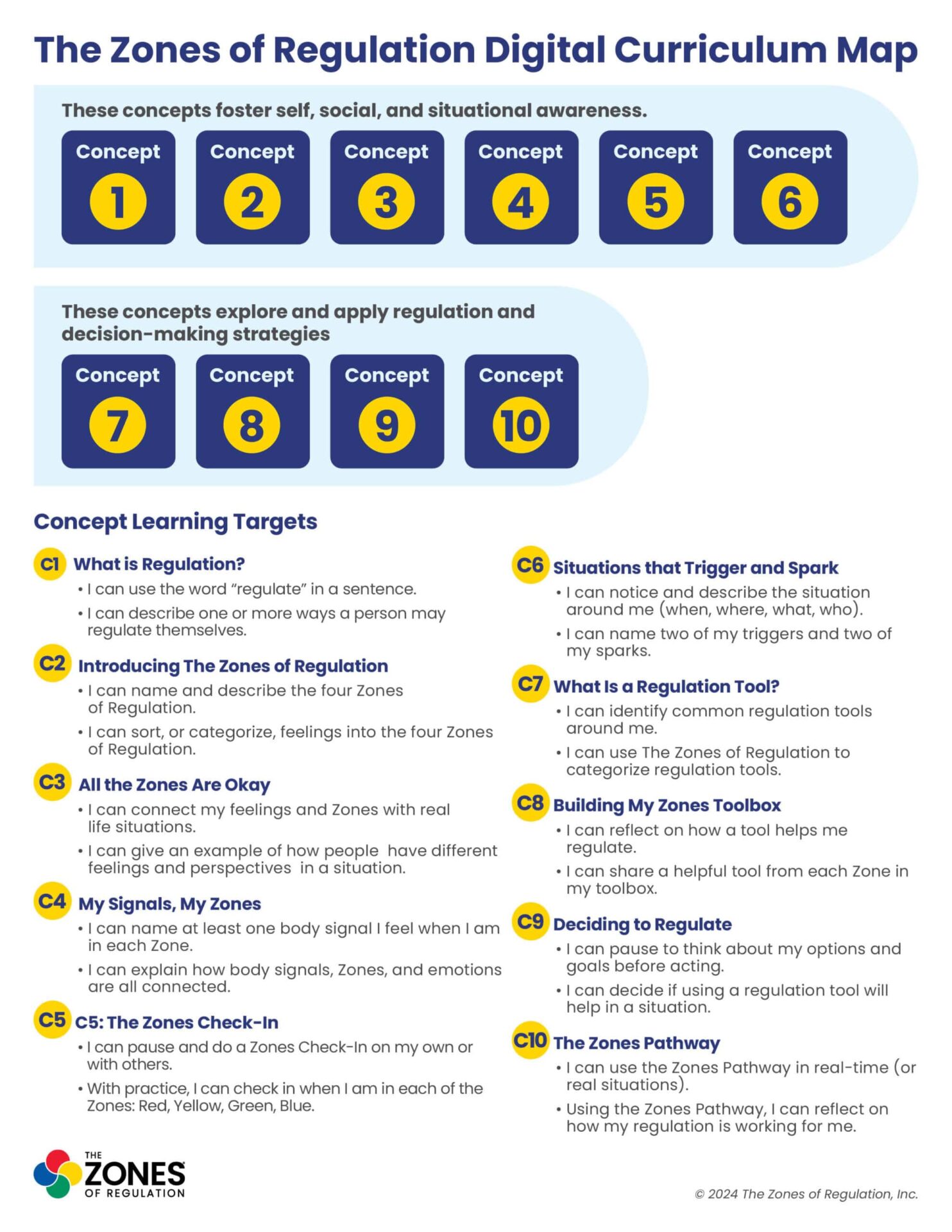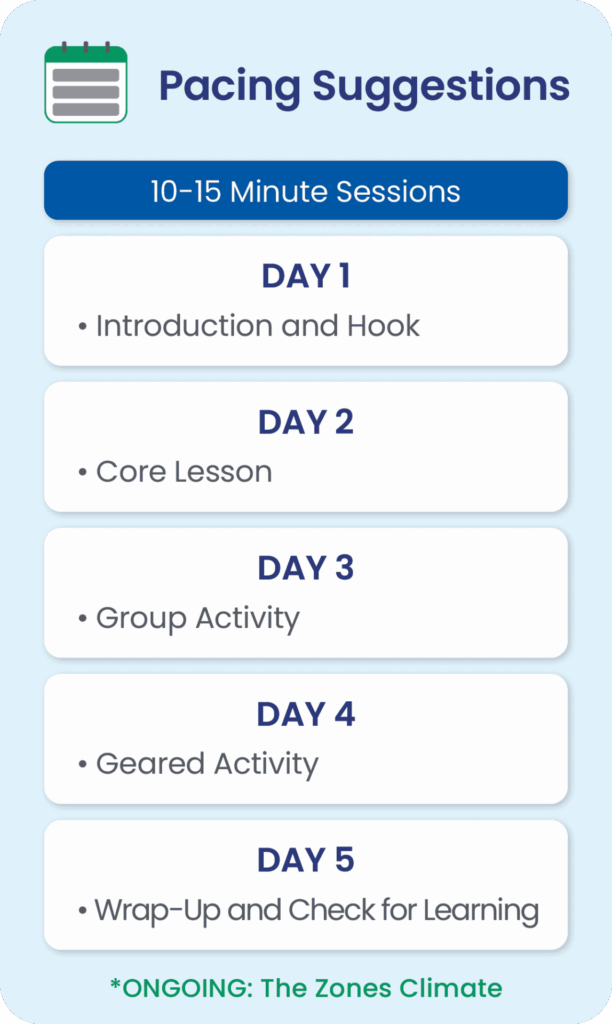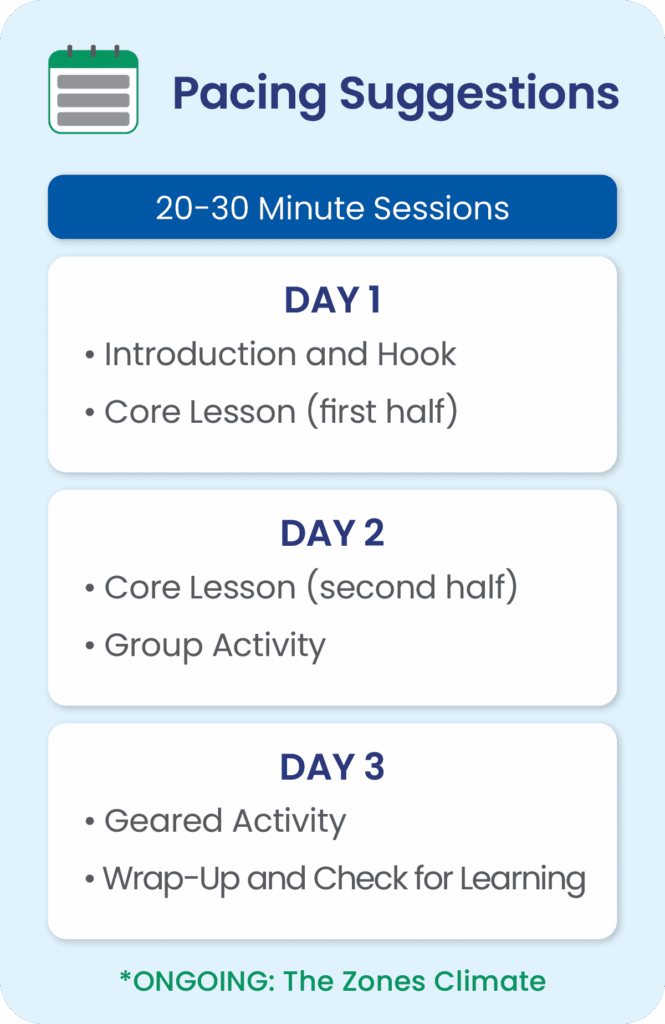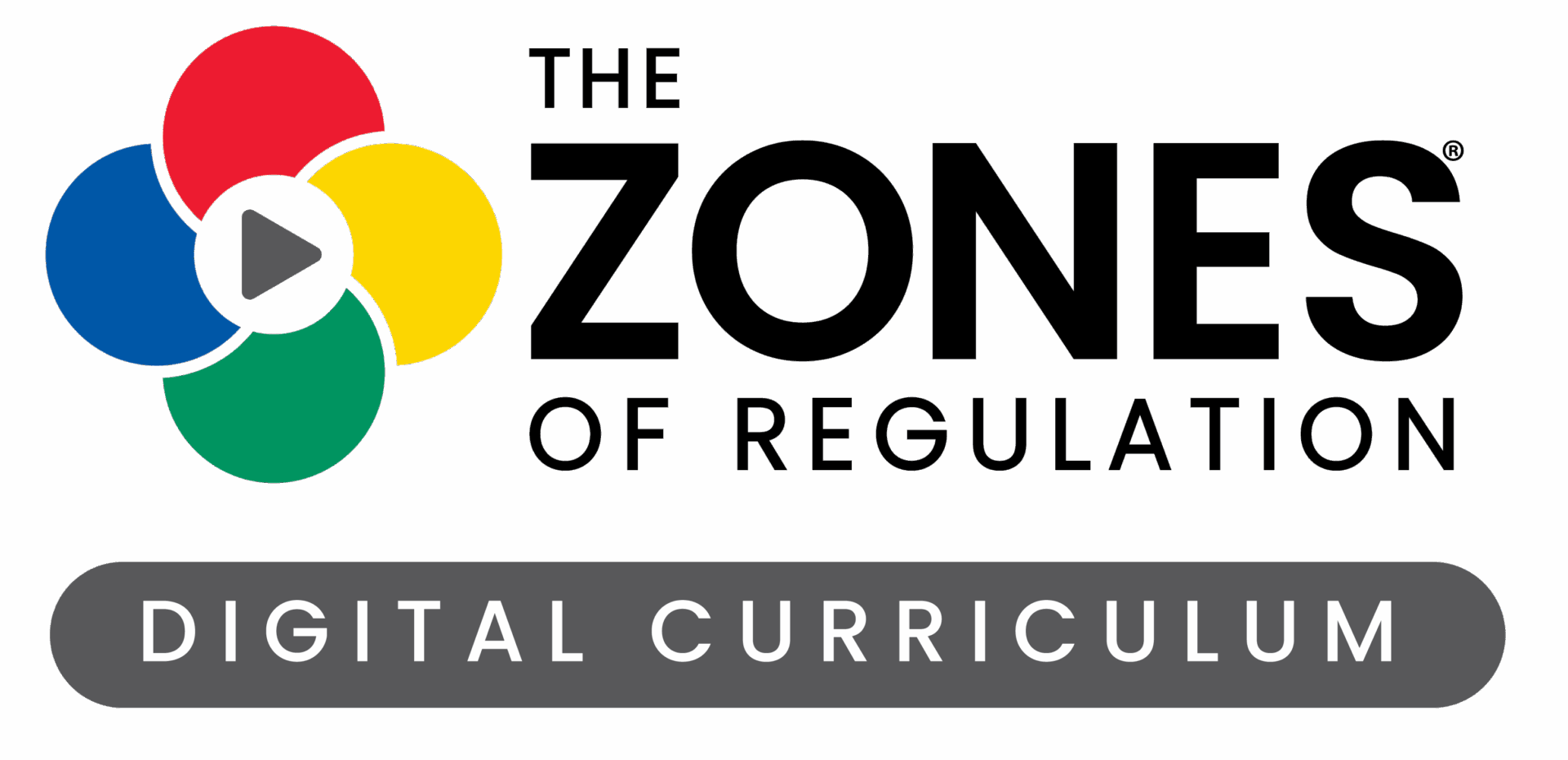Curriculum Overview and Guidelines
The concepts within the curriculum build upon each other, with later concepts expanding upon skills, lessons, and vocabulary taught in earlier ones. For example, learners need to name and explain the four Zones of Regulation (Concept 2) before they can check in in each of the four Zones (Concept 5).






Concepts 1–6: Foster self-, social, and situational awareness. After defining regulation, the focus is on building emotional awareness by first exploring feelings and states in others and how they relate to The Zones, establishing that all our feelings and Zones are okay. Then we advance to self- exploration, including identifying interoceptive body sensations and signals that help learners recognize how they are feeling. Learning progresses to the Zones Check-In, teaching learners to be mindful in the moment of how they are feeling. Learning culminates with learners digging into situational awareness and its impact on their feelings/Zones. This includes exploring the triggers and sparks that affect their feelings and regulation. Understanding different perspectives is woven across concepts.




Concepts 7–10: Explore and apply regulation and decision-making strategies. We begin the second half of the curriculum by introducing regulation tools and how they help to regulate each Zone. Learners explore various tools and strategies with the Tool of the Week and create a customized Zones Toolbox. Next, the focus shifts to supporting learners in decision-making around regulation, including using Stop, Opt & Go as a strategy to pause before we act, think through our options, and use our goals to help decide what option will work well. Learning culminates with The Zones of Regulation Pathway, which provides concrete steps to apply the concepts taught in real time, while deepening learners’ metacognitive regulation strategies and self-reflection abilities.

Adult Learning Modules
In the Training area, you will find four valuable and engaging Adult Learning Modules to develop the foundational understanding needed to teach The Zones with confidence, integrity, and fidelity.
Module A: What is Regulation?
Module B: Beyond Behavior: Factors Impacting Regulation
Module C: What is The Zones of Regulation?
Module D: Building the Zones Climate
The instructional resources within The Zones of Regulation Digital Curriculum are a mix of digital and non-digital supports.
An introduction at the top of each Concept provides background information and instructional suggestions to prepare you for effective teaching.

PRESENTATION GUIDE
Provides leaders with detailed step-by-step instruction for teaching each Interactive Presentation, much like what one would see in a lesson plan. In addition to instructional and planning guidance, key parts include:
- Detailed instructions and key scripting
- Accessibility and Adaptations for more support
- Teaching Tips for scaffolding, deepening, and extending key lesson concepts
- Alternative Activities to supplement or replace select digital activities with real objects or “live” off-screen instruction

INTERACTIVE PRESENTATION
Learner-facing slides, activities, and videos designed to engage learners through instruction via Smartboard, screen, projector, computer, or tablet. Each Interactive Presentation includes the following:

LEARNING TARGETS: Learner-facing objectives

KEY VOCABULARY: Essential terminology

HOOK: A brief activity that engages learners and “hooks” them on the lesson

CORE LESSON: Direct instruction on learning targets

GROUP ACTIVITY: A hands-on activity that helps learners meaningfully apply the Learning Targets

GEARED ACTIVITIES: A menu of supplemental differentiated activities designed to apply, extend, or reinforce concepts being taught. These enrichment activities support learners across a developmental continuum of abilities.

WRAP UP: Learners review the Learning Targets and key concept information, while also being prompted to consider ways to apply this new knowledge to their daily lives.

CHECK FOR LEARNING
A quick formative assessment to assess learners’ progress toward the concept Learning Targets.

BRIDGE
A summary of each concept to share with others who support learners, including caregivers and support team. Each Bridge includes pertinent concept information and visuals, as well as a fun activity to support generalization.

ZONES VISUALS
Bring The Zones to life in your setting with these visuals that reinforce and extend key Zones concepts.

EXTEND LEARNING
A section at the bottom of each concept provides ways to integrate learning into your climate, communicate with caregivers and support team members, and use additional Zones resources.
Teaching The Zones involves a lot more than putting up visuals and suggesting learners regulate with a tool. To teach The Zones of Regulation with fidelity, we recommend the following exposure for learners as a best practice:
- MINIMUM of 4 months devoted to teaching and reinforcing the concepts from The Zones Digital Curriculum
- MINIMUM 40 minutes of direct instruction per concept (can be spread out over a week or more)
- ONGOING exposure to the Essential Elements for a Zones Climate

Concepts within The Zones Digital Curriculum are designed to be taught during multiple sessions so learners have time to explore, practice, and apply what they are learning. Pacing will vary depending on your schedule and your learners. You will find a Pacing Suggestions section within the Introduction for each concept, that breaks it down into 2-3 teaching sessions. There are further suggestions for adapted pacing within the Considerations and Adaptations — Early/Emergent Learning suggestions. Please note that pacing is flexible and should be guided by learners’ understanding. Ultimately you, as the leader, should determine what is best for your learners. Here are two ways to pace a concept based on instructional time:


*The Zones Climate includes essential strategies to integrate and generalized learning within your setting. You will find a suggested Key Climate Practice as well as Additional Zones Climate Practices within each concept.
Recommendations for Concept Pacing
Observe how learners apply the concepts and demonstrate knowledge in everyday situations, before moving on to a new concept that may include more complex/advanced skills and content and/ or prerequisite knowledge. For example, if learners are challenged by checking-in in Concept 5: The Zones Check-In, continue building self-awareness and revisit Concept 4: My Signals, My Zones to explore more signals associated with different Zone feelings.
You may find it useful to break down some concepts even further and teach them over several weeks. For example:
- With “Concept 2: Introducing The Zones of Regulation,” after teaching the Hook in one session, break the Core Lesson into four sessions, using each session to introduce one of the four Zones.
- Or, for “Concept 4: My Signals, My Zones,” after teaching the Hook in one session and the Core Lesson in one session, break apart the Group Activity into four mini-sessions, using each session to teach signals for one Zone.
Use the suggestions in the Keep It Real! section of the Interactive Presentation, the Geared Activities, and the Zones Climate to help learners grasp the concept and meaningfully apply it to their lives.
Use the Concept Planner to help you organize and track your instruction.
We recommend that concepts be taught in order, as each concept builds upon skills acquired in the prior concepts. Teaching the 10 concepts, at a minimum, should span 4 months, spending roughly at least a week on each concept. It is not necessary to teach a new concept every week. Moving too fast through the curriculum can cause learners to shut down, feel unsuccessful, and oppose doing anything “Zones” related. We never want The Zones to become a trigger for learners, leading them to a dysregulated state.
Spiraling is reinforcing previously learned concepts for learners. This leads to better long-term mastery of information, skills, and concepts. Spiraling helps learners make and keep connections over time, which creates more robust pathways for recalling information.
Spiraling Within the Instructional Period
Though we recommend you teach the Zones Concepts in order, we also recommend spiraling back to previously taught concepts to revisit skills throughout an instructional period (such as a school year). Spiraling Zones Concepts can look like any of the following examples:
- After teaching “Concept 4: My Signals, My Zones,” revisit “Concept 2: Introducing The Zones of Regulation,” to explore and expand emotional vocabulary within the four Zones.
- After teaching “Concept 5: The Zones Check-In,” revisit “Concept 4: My Signals, My Zones,” to identify new body signals.
- After teaching “Concept 8: Building My Zones Toolbox,” revisit “Concept 6: Situations that Trigger and Spark,” to identify new triggers and sparks.
- After teaching “Concept 10: The Zones of Regulation Pathway,” revisit “Concept 8: Building My Zones Toolbox,” to refine and expand the tools in your toolboxes.
- Updating visuals over the scope of instruction
The Zones of Regulation can be used as a schoolwide (Tier-1) curriculum, in which it is taught across grade levels, year after year. Since The Zones of Regulation Digital Curriculum builds on a metacognitive framework that we want learners to internalize, it’s important to revisit the curriculum to strengthen the development of regulation competencies. Within each concept, you have flexibility as to how to best introduce and revisit the content using components including the Interactive Presentation, Group Activity, and Geared Activities. Use each concept’s Check for Learning to assess what instruction is needed for your learners, and gauge to what depth you will extend learning as they grow and develop. Here are some considerations based on grade level for year two implementation and beyond:
- Lower grade leaders may introduce portions of a concept’s Interactive Presentation with learners, and then select Gear 1 or 2 activities to work toward the learning targets with different levels of support and depth.
- Upper grade leaders may scale back instruction and exposure, for example, only using the video and Pair & Share from the Interactive Presentation in tandem with a Gear 3 activity choice.
In all grade levels and years of implementation, it is essential to annually review the 4 Signature Practices to reestablish common language, practices, and The Zones Climate with learners.
3 Ways to Adjust the Curriculum Over the Years
- Modify the Interactive Presentation
- Vary Selection of Geared Activities
- Adjust Instructional Time
In the downloadable resource shown to the right, we describe each of these ways, and include a sample K-5 alignment chart.
During the design of The Zones Digital Curriculum, we worked closely with CAST, a nonprofit education research and development organization leader in inclusive education that created the Universal Design for Learning framework and UDL Guidelines. Like CAST, we believe that all learners deserve access to high-quality, equitable educational resources that offer meaningful and challenging learning opportunities. We strive to ensure that learners from all backgrounds, economic statuses, or circumstances, as well as those with disabilities, can engage with all of our content and visuals and find their learning inclusive and engaging. UDL best practices are integrated throughout the Digital Curriculum’s design, content, and instructional materials.
UNIVERSAL DESIGN FOR LEARNING (UDL) GUIDELINES:
The UDL Guidelines are a tool used in the implementation of Universal Design for Learning. These guidelines offer a set of concrete suggestions that can be applied to any discipline or domain to ensure that all learners can access and participate in meaningful, challenging learning opportunities.

The Zones of Regulation curriculum can easily be adapted and woven together with other social emotional learning (SEL) curriculum and practices, such as comprehensive SEL curricula, restorative practices, and programs that address sensory integration, mindfulness, yoga, character building/growth mindset, and conflict resolution skills. For example, when learning about yoga poses, present them as regulation tools and have learners sort them into the Zones they help regulate; or when learning about growth mindset, connect The Zones to the various thinking patterns explored. When implementing The Zones, you create a common language and healthy climate while building a metacognitive approach to regulation that can serve as a strong foundation to use with a wide range of other SEL resources. When implementing other programs consider the following steps:
- Map out strengths, overlaps, and unique characteristics of each program.
- Develop an implementation plan detailing pacing for layered instruction.
- Teach the four Signature Practices and utilize Essential Elements of a Zones Climate as a foundation. (See Adult Learning Modules C and D.)
For additional information on how The Zones of Regulation Digital Curriculum aligns with the CASEL Core Competencies, see the attached PDF.









